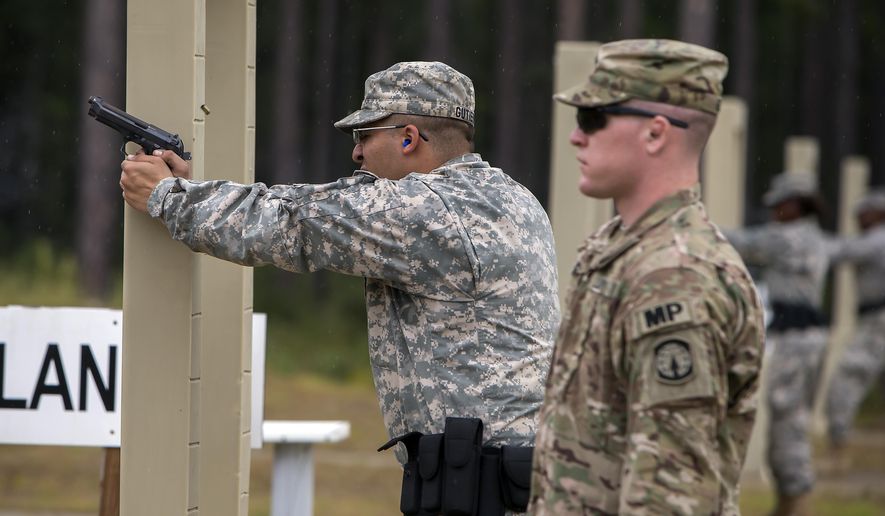Defense Secretary James N. Mattis’ Senate confirmation hearing dealt with not only the large challenges of Vladimir Putin and the Islamic State, but also one of the smallest items in the U.S. arsenal.
The issue: It has taken the Army an agonizing decade to write the requirements, evaluate the candidates and pick a successor to the 30-year-old Beretta M9 pistol.
Sen. Joni Ernst, Iowa Republican, vented directly to Mr. Mattis, asking how such a simple system could bedevil the Army procurement apparatus. Senate Armed Services Chairman John McCain, Arizona Republican, had become so frustrated at one point that he issued a special report on the unneeded complexity of buying a sidearm.
The Army now asserts that the next-generation sidearm is not a problem Mr. Mattis will have to tackle.
Army headquarters at the Pentagon, on the eve of Donald Trump’s succession to the presidency, proudly announced that small arms maker Sig Sauer won the competition to make the Modular Handgun System.
The contract will contain a price “ceiling,” the Army said, the kind of cost control businessman Donald Trump has embraced as he stings the defense industry over cost overruns. Sig Sauer will provide the guns, accessories and ammo for no more than $580 million.
Next the Army will begin operational test-shooting aimed at sending the weapon to soldiers later this year.
Sig Sauer was founded in Switzerland more than a century ago. It now makes America a major hub of operations. In 2014 it opened a new corporate headquarters in Newington, New Hampshire.
The company’s motto: “Born in Europe, Perfected in America.”
The Army announcement was celebratory.
“I am tremendously proud of the Modular Handgun System team,” said Army Acquisition Executive Steffanie Easter. “By maximizing full and open competition across our industry partners, we have optimized private sector advancements in handguns, ammunition and magazines, and the end result will ensure a decidedly superior weapon system for our war fighters.”
At Mr. Mattis’ confirmation hearing a week earlier, Ms. Ernst used much of her allotted time to condemn what she believes is the poor state of the armed forces’ small arms.
Her target was not just the 30-year-old Beretta. The Army’s M4 carbine, its mainstay rifle, is often criticized by front-line combatants as prone to jamming and as lacking firepower.
“The Army can’t even figure out how to replace the M9 pistol, first issued in 1982,” the senator told Mr. Mattis. “Take a look at their 350-page micromanaging requirements document if you want to know why it’s taking so long to get this accomplished. Our military’s current service rifle that, as you noted, is illegal for shooting small deer in nearly all states due to its lack of killing power. Do you agree that we cannot grow a more lethal force while using outdated small arms and ammunition?”
“I do agree with that approach, ma’am,” said Mr. Mattis, a retired four-star general. His 44-year career in the Marine Corps subjected him to all sorts of firearms, including the Vietnam-era M16, whose updated models are used by Marines today.
“I think one place you need to start is with our military small arms,” the senator told Mr. Mattis. “Russia continues to upgrade its service rifle and all, while we continue to modify our M4s. Many of our troops still carry M16s.”
Said Mr. Mattis, who retired in 2013: “I have been away for several years, and as you know, the Army, the special forces, the Marines have all been working on creating a more lethal round for the M16 and the M4.”
Ms. Ernst, who spent 23 years in the Army National Guard and the Reserve, later took to Twitter.
“I was also glad last week to hear General Mattis say he would work with me to address our military’s outdated weapon systems,” she tweeted.
In the fall of 2015, Mr. McCain became so frustrated by the long march to find what should be a simple procurement he issued a special report, “America’s Most Wasted: Army’s Costly Misfire.”
He said the Army had spent 10 years preparing a competition for a $500 gun.
“The Army has managed to create entirely new acquisition problems for what should be a simple, straightforward purchase of a commercially available item,” Mr. McCain said.
“The Army’s effort to buy a new handgun has already taken 10 years and produced nothing but more than 350 page[s of] requirements micromanaging extremely small unimportant details and Byzantine rules and processes the Army wants followed, many of which are unnecessary or anticompetitive,” he said.
• Rowan Scarborough can be reached at rscarborough@washingtontimes.com.




Please read our comment policy before commenting.